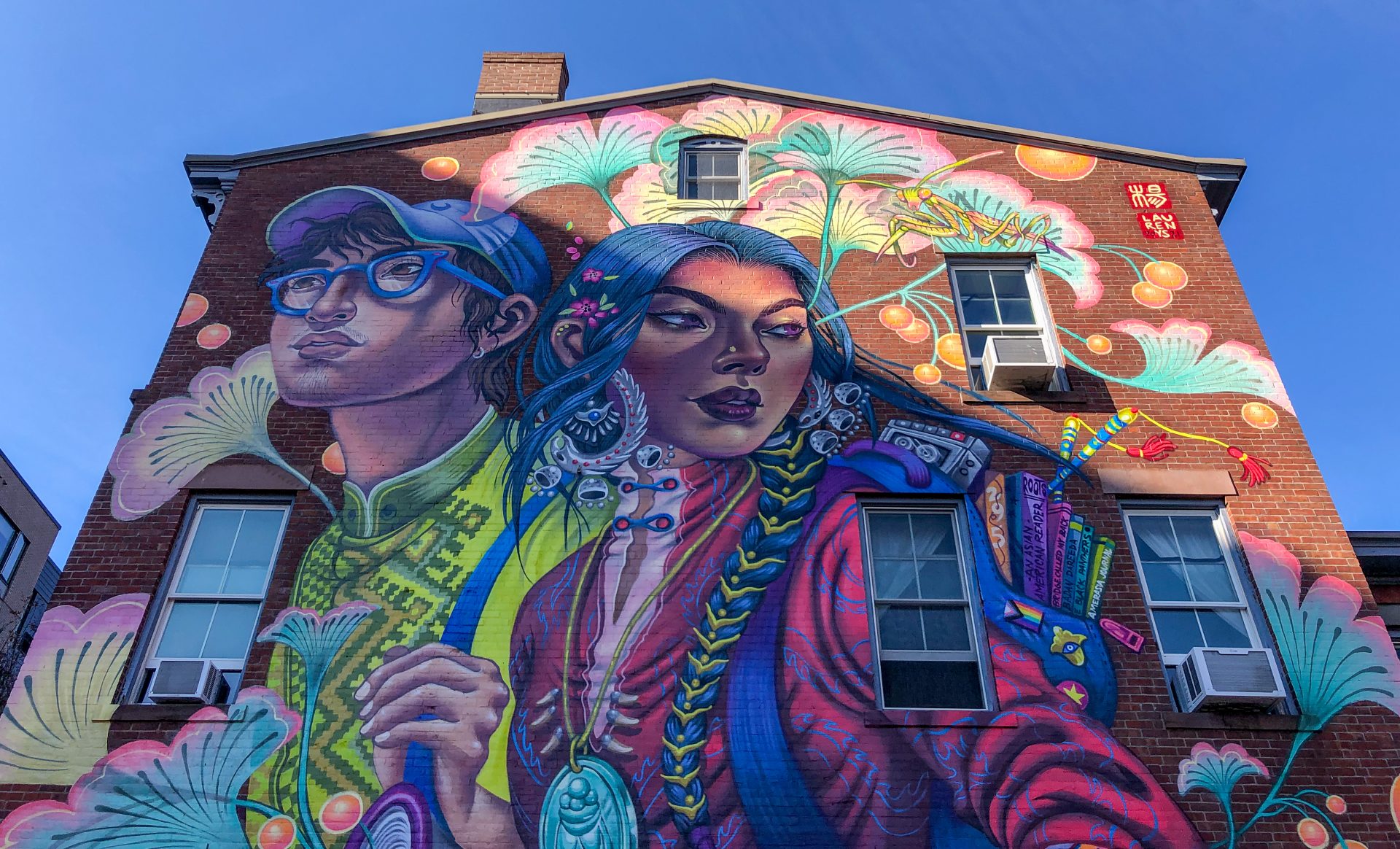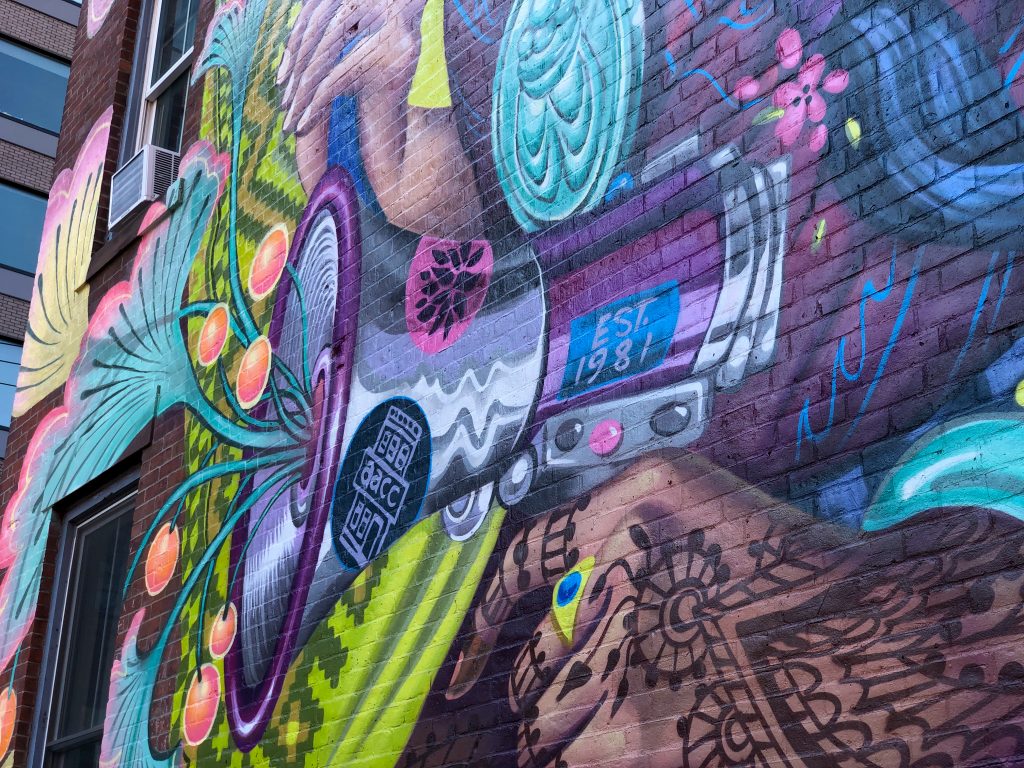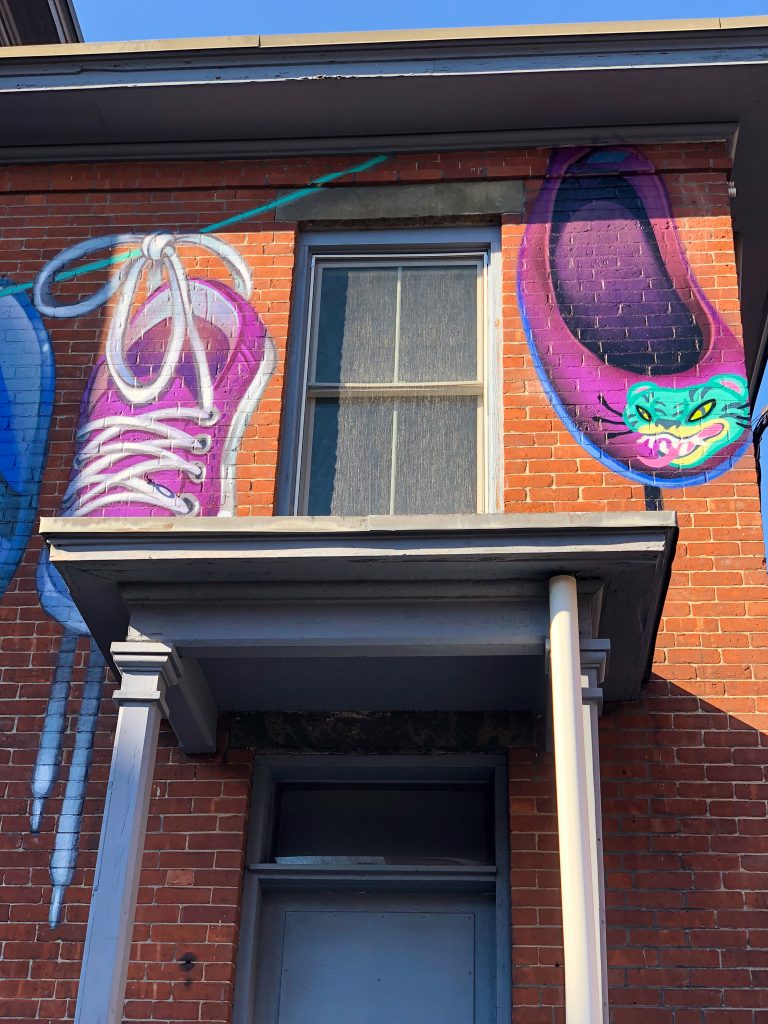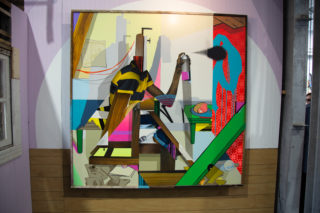Inspired by the existing murals filling both sides of Yale University’s La Casa Cultural de Julia de Burgos building, the luminescent Finding Home now stands as a third testament recognizing and commemorating the ever-expanding myriad of cultural identities that make up the Yale student body.
In November 2021, Los Angeles-based artist Lauren YS came to New Haven to collaboratively create the third in this informal series of works, this one dedicated to the AAPI community. Commissioned as part of a residency with the Asian American Cultural Center at Yale, the building of which stands just next to La Casa Cultural on Crown Street, Lauren YS’ Finding Home reveals two young gender-nonspecific Asian characters moving powerfully forward, carrying and surrounded by vibrant iconography celebrating the manifoldness and magnitude of the cultural depth within Asian American histories and communities: One of the characters wears a backpack with books referencing AAPI history and the Black Panther movement, and holds a megaphone from which ginkgo leaves and seeds spill and blossom out to frame the two friends as they work towards the bright future they embody.
In 1994, Rafael Weil joined with local artists to create Mural for Casa Cultural: Julia de Burgos, and in 2004 the other side of La Casa Cultural’s building became the canvas for Mural for Latinx Unity, created by art students Maceo Montoya and Francisco Delgado. Now, with Lauren YS’s contribution, Yale’s public visual praise of non-white identities continues. While in New Haven, the artist spent time with Yale art students and shared their practice through virtual talks, all while creating this three-story, two-wall mural that through refraction and reflection literally lights up the intersection at Crown and High Streets. “I loved being around students again, having such rich and provocative conversations at every turn, and being reminded of the rich energy that comes from young people pursuing their interests in each other’s company,” the artist shared about their time at AACC, “I also absolutely loved visiting students’ studios and had so many exciting conversations about praxis and heritage that I left the studios literally buzzing!”
Back to completing murals around the world, Lauren YS was kind enough to share more about what led to Finding Home in this special online interview:
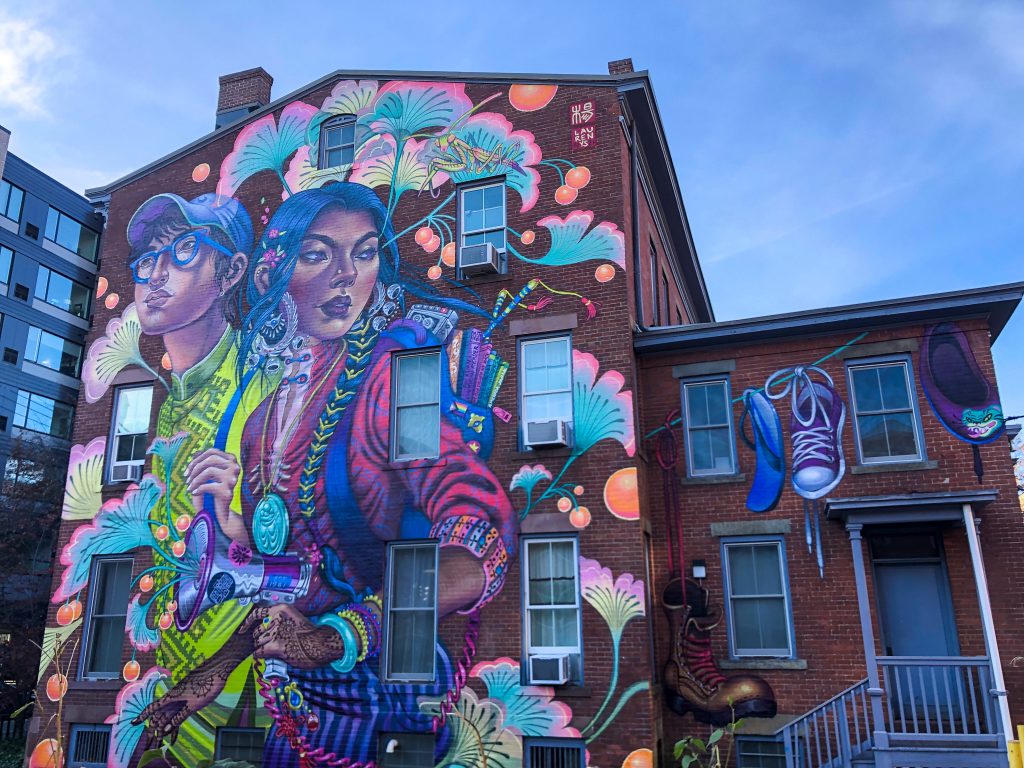
How do your intended symbols for a piece (or your use of symbolism in general) affect its ultimate composition?
I think the two both evolve organically, but generally, I try to design an image to command the wall first and then through research try to intuit something that would fit the feeling I’m looking for. In this case, I really wanted to brick of the building to shine through, since the buildings in New Haven have so much character and the building blocks of the AACC are so historically salient, so I wanted design elements that would create some kind of latticed effect to let the brick show through.
I knew I wanted the two characters to have that ‘striding forward’ feeling, so that element did not change, but all of the symbolism interlaced through the characters evolved from my research on Asian symbolism/botanicals native to New Haven. As we added symbols and elements, I just adjust them to have a sense of motion and dynamism that flows through the image. The goal is to always create a sense of movement—that is the magic of painting static images.
What does the title Finding Home mean to you in the context of your practice as a global street artist?
I suppose the sentiment of ‘finding home’ is meaningful to everyone in its own way, and for me, it felt resonant with the history of the AACC, as so much of the stories we tell as students, children and grandchildren of immigrants, and young people in this journey of searching out a place for ourselves in the world. As a grandchild of immigrants from war-torn China and Germany respectively, I feel a strong communion with the immigrant experience, which defines so many students who travel to build a future inside the walls of a university, as so many of the founders of the AACC did.
Beyond that, the practice of creating murals globally does indeed have its own sense of “home-finding” intrinsically packed into it, as there is this repeated experience of setting up to create something in a new space, entering into its community and spending powerful and energetic time there for a moment before moving on.
In this sense, I understand “home” as a moving target woven by the power of experience and defined by ephemeral space rather than something more concrete, which I believe is also resonant with the student experience and the greater question of our human quests for the purpose at large.

I understand “home” as a moving target woven by the power of experience and defined by ephemeral space rather than something more concrete, which I believe is also resonant with the student experience and the greater question of our human quests for the purpose at large.
The Yale Daily News reported that you went through “rounds of community feedback sessions” for the mural. What was this process like for you, how much did it impact the final approved design, and how did it compare to past committee-approval processes for public commissions?
When we initially spoke about making edits to the piece, the committee wanted to make sure we spoke further about representation, as my design was organized to only fit two characters to make the most use of the available wall space. I was very excited to open this conversation as it is such an important element of planning in any work that pays homage to a particular diaspora, and I asked if it was possible to plan some kind of community feedback sessions where I could interface with students/professors/community members to get more voices involved in the topic of representation.
This process was deeply important as I think it reflects the larger conversation happening in the world about the Asian-American diaspora at large: this pressing need to discuss how it is not a monolith; and the absolutely immense array of cultures and people that exist beneath its umbrella, and the way they are represented in our activism, celebrations and memory. I sensed there was a particular dynamic at the AACC in which it didn’t necessarily feel like there was enough representation for south and southeast Asian students, and we worked together to edit the image so that it would be more welcoming in this way.
As an east Asian artist I have always painted from my experiences, but these instances of community feedback were extremely powerful and edifying as community members offered a wealth of input on how to create a more inclusive image. I am so grateful for this experience as I think it mirrors the need for more diverse representation within all expressions of Asian-American identity, and intend to carry it into all future projects.

How do approved and commissioned projects like this one factor into your larger practice as both an artist and a street artist? In what ways do you see the public and interior, or commercial aspects of your practice as interrelated?
Projects like this are very dear to my heart as it isn’t often you get the chance to open yourself to public critique, especially from a community as passionate and intelligent as the Yale community. I think it’s deeply important to be invested in the communities your art will live in, and so reflect the kind of people, wildlife, botanicals, and elements of daily life that are important to them, as much as it is within your capability.
I don’t often do work that is so commercial that any entity has more control than I do (those kinds of jobs don’t often come my way, for whatever reason) so I feel very lucky that I am able to create with freedom, as I really believe walls have so much power for telling stories and creating representation beyond the commercial, but I really loved the process of interfacing with such brilliant minds and hope to do more in that vein.
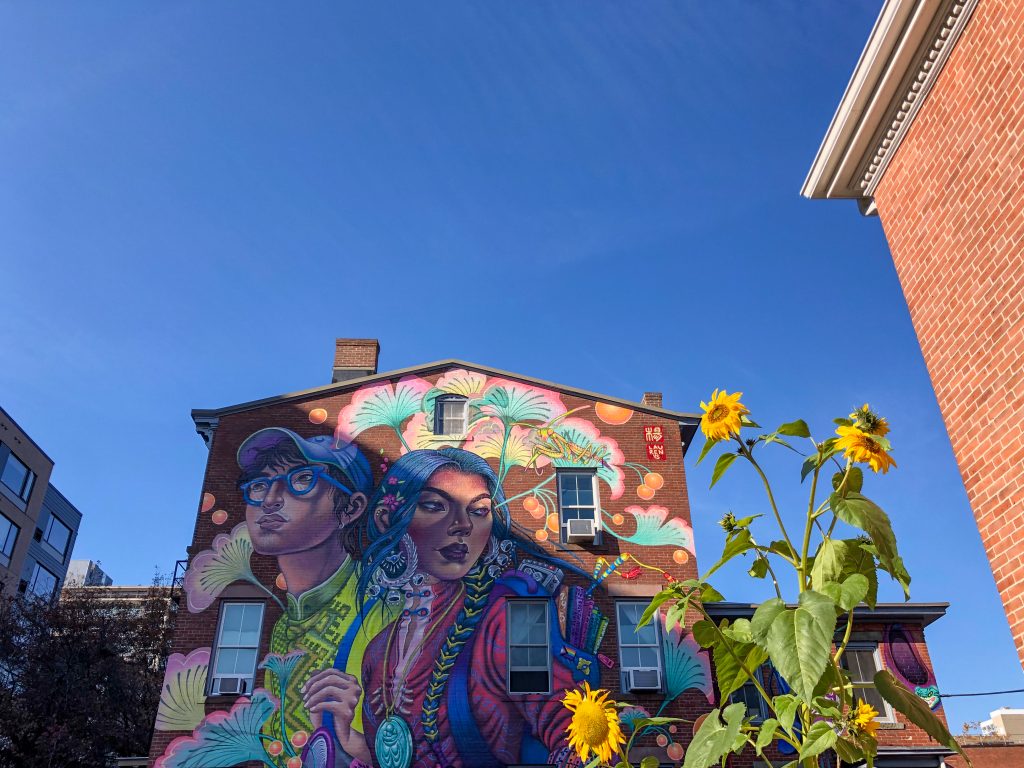
How do you envision the interconnectedness of the spiritual and the mythological through your stunning use of colors within each composition?
Color is something that also comes kind of intuitively — I think I knew I wanted to tell a story through particularly the textiles and botanicals in the image, so I sculpted the color flow to react with these very rich reds, blues, purples and greens that are meant to draw the mind to the south and southeast Asia.
While I often gear towards really hyper-chroma, psychedelic color fields, I wanted to approach this wall with a more mature palette so that it would interact peacefully with the landscape of New Haven rather than interrupting it, while still bringing vibrancy to the area. I shifted the colors of the ginkgo leaves from full green to a more juicy pink-and-coral palette to reflect the changing seasons on the East Coast, and sort of let the rest of the image react as I painted it. Sometimes it’s best to just order a nice palette and paint within those restrictions and see what comes of it. Thank you Montana Cans for sponsoring this project!
…I feel very lucky that I am able to create with freedom, as I really believe walls have so much power for telling stories and creating representation…

